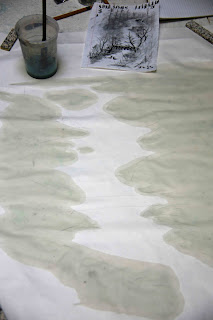Parallel to the creek runs a trail, partly dirt and gravel, and partly constructed of wooden planks. This trail starts at the little lookout area and then follows the bank. I am having great difficulty with painting this trail because I really don't have a clear image as to how this trail should look like on paper. I just haphazardly plotted the footprint and will deal with it later.
The leaves would assume different colors. It would be boring if all of them were green. I decided to have green, yellow, red, crimson, and blue leaves. It is not uncommon for Blue Hue Three (176) to be used as a leaf color; it is like a punctuation mark! That and Green Label Hue Three(173).
For these leaves I would use yellow as the base coat. It is important to write the color in using brushstrokes. Forsake the temptation to just block in the entire area. In this particular example, the leaves are little rectangles. So using the brush tip, start at the point, press and lift at the opposite side. As we pile on layers of color, the tone becomes more saturated.
The different colors tend to carve out a tiny margin around themselves (perhaps due to brushstrokes not exactly the same as I repeat the process) and give the leaves a thickness. I would pile cinnabar on yellow, then carmine on top of that, for example. After the entire painting is done, I would then re-outline the leaves and trunks for a better definition.
I now need to put in the grounds. What I had was a faint green smudge with dark outlines. I would go over the entire ground with brown (684) mixed with ink, taking care to leave the highlighted areas uncovered. By selectively using different tones of brown, and subsequent highlighting with Green Label Three again, I can map out the contour and the topography of this landscape and render a three dimensional feel to it.
Stepping back and look at the painting. On the lower right hand corner I have a tree in the middle of the trail. Looks bad! So I decided to paint in some foliage around the base to make it less obvious. I also embellished the trail with blades of grass or vegetation here and there. I would probably write in some moss dots too, but I'll wait until the painting is almost done.
Once that problem is fixed, the left side of the bridge looks naked. I had the small trees there to conceal the entrance, but there was no hint of a path leading to the bridge and thus the bridge seem detached and was not connected to the painting emotionally. My faithful foliage came to the rescue again. These leaves could be shrubs, or they could be from the trees; a little added intrigue for the audience!
I also darkened the sky somewhat, such that it is now connected to the rest of the painting.
A margin of green around the shores to frame the landscape. I use that as a minimalistic representation of reflections, certainly in accordance with classical Chinese Brush painting doctrine.
to be continued.






































